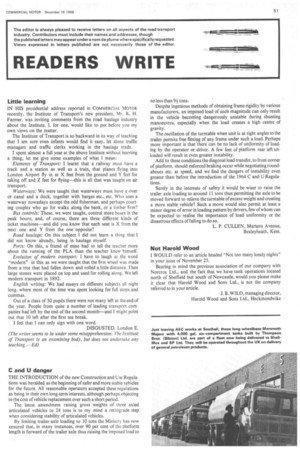READERS WRITE
Page 53

If you've noticed an error in this article please click here to report it so we can fix it.
Little learning IN HIS presidential address reported in COMMERCIAL MOTOR recently, the Institute of Transport's new president, Mr. R. H. Farmer, was inviting comments from the road haulage industry about the Institute. I, for one, would like to put before you my own views on the matter.
The Institute of Transport is so backward in its way of teaching that I am sure even infants would find it easy, let alone traffic managers and traffic clerks working in the haulage trade.
I spent almost a full year at the above Institute without learning a thing; let me give some examples of what I mean: Elements of Transport: I learnt that a railway must have a track and a .station as well as a train, that planes flying into London Airport fly in at X feet from the ground and Y feet for taking off and Z feet for flying—this is all that was taught on air transport.
Waterways: We were taught that waterways must have a river or canal and a dock, together with barges etc., etc. Who uses a waterway nowadays except the odd fisherman, and perhaps courting couples who go for walks along the bank, or a timber firm?
Bus controls: These, we were taught, control more buses in the peak hours; and, of course, there are three different kinds of ticket machines—and did you know that each seat is X from the next one and Y from the one opposite?
Road haulage: On this subject I did not learn a thing that I did not know already, being in haulage myself.
Ports: On this, a friend of mine had to tell the teacher more about the running of the PLA than the teacher knew himself.
Evolution of modern transport: I have to laugh at the word "modern" in this as we were taught that the first wheel was made from a tree that had fallen down and rolled a little distance. Then large stones were placed on top and used for rolling along. We left modern transport in 1892.
English writing: We had essays on different subjects all night long, where most of the time was spent looking for full stops and commas.
Out of a class of 50 pupils there were not many left at the end of the year. People from quite a number of leading transport companies had left by the end of the second month—and I might point out that 10 left after the first tea break.
I feel that I can only sign with one word.
DISGUSTED. London E. (The writer seems to be under some misapprehension. The Institute of Transport is an examining body, but does not undertake any teaching.—Ed) C and U danger
THE INTRODUCTION of the new Construction and Use Regulations was heralded as the beginning of safer and more stable vehicles for the future. All reasonable operators accepted these regulations as being in their own long-term interests, although perhaps objecting to the cost of vehicle replacement over such a short period.
The latest amendment raising gross weights of three axled articulated vehicles to 24 tons is to my mind a retrograde step when considering stability of articulated vehicles.
By limiting trailer-axle loading to 10 tons the Ministry has now ensured that, in many instances, over 90 per cent of the platform length is forward of the trailer axle thus raising the imposed load to no less than 9+ tons.
Despite ingenious methods of obtaining frame rigidity by various manufacturers, an imposed load of such magnitude can only result in the vehicle becoming dangerously unstable during shunting manoeuvres, especially when the load creates a high centre of gravity.
The oscillation of the turntable when unit is at right angles to the trailer permits free flexing of any frame under such a load. Perhaps more important is that there can be no tack of uniformity of loading by the operator or driver. A few feet of .platform rear left unloaded will result in even greater instability.
Add to these conditions the diagonal load transfer, to front corner of platform, should enforced braking occur while negotiating roundabouts etc. at speed, and we find the dangers of instability even greater than before the introduction of the 1964 C and U Regulations.
Surely in the interests of safety it would be wiser to raise the trailer axle loading to around II tons thus permitting the axle to be moved forward to relieve the turntable of excess weight and creating a more, stable vehicle? Such a move would also permit at least a minor degree of error in loading pattern by drivers, few of whom can be expected to realise the importance of load uniformity or the disastrous effects of failing to do so.
L. P. CULLEN, Martens Avenue, Bexleyheath, Kent.
Not Harold Wood
I WOULD refer to an article headed "Not too many lonely nights" in your issue of November 25.
Bearing in mind the previous association of our company with Norcros Ltd., and the fact that we have tank operations located north of Sheffield but south of Newcastle, would you please make it clear that Harold Wood and Sons Ltd., is not the company referred to in your article.
J. B. WILD, managing director,
Harold Wood and Sons Ltd., Heckmondwike




























































































































